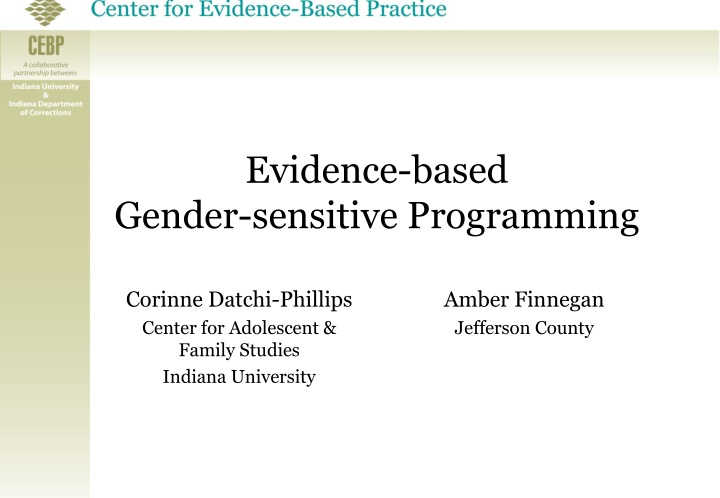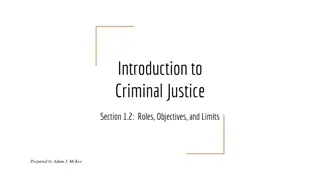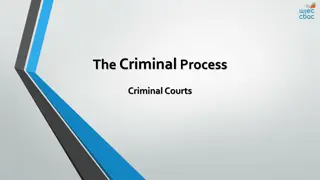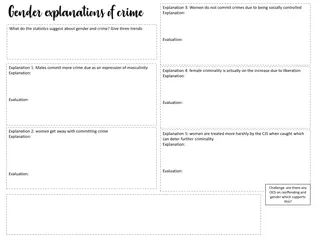Female Offenders in the Criminal Justice System: Trends and Statistics
Women and girls are a growing segment of the offender population, with significant increases in incarceration rates and involvement in the criminal justice system. This evidence-based and gender-sensitive programming sheds light on the prevalence and growth rate of female offenders, highlighting the need for gender-specific approaches in addressing their unique needs.
Download Presentation

Please find below an Image/Link to download the presentation.
The content on the website is provided AS IS for your information and personal use only. It may not be sold, licensed, or shared on other websites without obtaining consent from the author.If you encounter any issues during the download, it is possible that the publisher has removed the file from their server.
You are allowed to download the files provided on this website for personal or commercial use, subject to the condition that they are used lawfully. All files are the property of their respective owners.
The content on the website is provided AS IS for your information and personal use only. It may not be sold, licensed, or shared on other websites without obtaining consent from the author.
E N D
Presentation Transcript
Evidence-based Gender-sensitive Programming Corinne Datchi-Phillips Center for Adolescent & Family Studies Indiana University Amber Finnegan Jefferson County
The female offender population PREVALENCE & GROWTH RATE
Female offenders Women and girls constitute a smaller but growing segment of the offender population. The majority of offenders serving prison terms or under community supervision are male. However, the number of women involved in the criminal justice system is growing at a faster rate than that of men (Institute on women & criminal justice)
Female Offenders Women in the criminal justice system Fastest growing segment of correctional population 757% increase between 1977 and 2004, twice as much as the 388% increase for men serving a sentence in prison In 2004, 1 in 8 parolees and 1 in 4 probationers were women. Percent of incarcerated women (over age 18) 8 6 4 2 0 1978 1997 2004 (Institute on Women & Criminal Justice; Justice Policy Institute, 1999; Lovins et al., 2007)
Female Offenders Women in the criminal justice system In Indiana, the number of incarcerated women (over age 18) has increased dramatically (from 5 per 100,000 in 1977 to 59 per 100,000 in 2004) 100 50 0 1977 2004 Percent increase 1977-2004: 1,347 % compared to 757% national rate Percent increase 1999-2004: 54% Female/male ratio: 26 male for every female prisoner in 1977 13 male for every female prisoner in 2004 (Institute on Women & Criminal Justice)
Female Offenders Women in the criminal justice system Increasing number of women (over age 18) on probation and parole nation-wide 30 20 Probation Parole 10 0 1995 2000 2004 2008 In 2004, 1 in every 8 adults on parole & 1 in every 4 adults on probation were women. (Probation & Parole in the US 2008, Bureau of Justice Statistics, December 2009; National Criminal Justice Reference Service)
Female Offenders Girls in the criminal justice system 29% of all juvenile arrests in 2005 34% of all juvenile arrests for Property Crime Index offenses 18% of all juvenile arrests for Violent Crime Index offenses 24% of all juvenile arrests for aggravated assault 33% of all juvenile arrests for simple assault
Female offenders Girls in the criminal justice system While the number of all juvenile arrests has decreased between 1996 & 2005, the number of girls arrested for simple assault has increased. (Office of Justice Programs, 2008) Percent Change in male & female juvenile arrests for violent crimes (1996-2005) 30 20 10 0 Girls Boys Aggravated Assault Simple Assault Violent Crime Index All crimes -10 -20 -30 -40
Female Offenders Girls in the criminal justice system Between 1990 & 1999, 50% increase in the number of girls in detention (4% increase for boys) Girls represented 19% of all juvenile offenders in residential placement in 2001 24% of girls detained for technical violations 43% of girls detained for status offenses (Sherman, 2005)
Important Questions Are there differences between female and male offenders? Are correctional systems (e.g., community corrections, probation, and parole) designed to adequately respond to the particular risks and needs of female offenders?
The female offender population GENDERDIFFERENCES
Gender Differences Different patterns of criminality (Sherman, 2005) Most arrests of female youths are for prostitution (67% of all juvenile arrests in 2002) and runaways (60% of all juvenile arrests in 2002). Running away from family violence, sexual or physical abuse Most girls in residential facilities are detained for status offenses and technical violations. Girls spend more time in detention although they may have committed fewer, less severe crimes than their male counterparts. Detention may be used to protect girls from further victimization; to obtain services for girls with special needs; or to prevent teen pregnancy (paternalistic approach to the sentencing of girls).
Gender differences Different patterns of violence (Bureau of Justice Statistics, 1999; Office of Justice Programs, 2008) Women and girls account for 14% of all violent offenders (1 out of 7 violent offenders) 28% of all female violent offenders are juveniles 3 out of 4 violent crimes committed by women and girls are simple assaults, most often against other women. 1 in 2 violent crimes committed by male offenders 62% of violent women offenders knew their victim. 36% of violent male offenders Family member, usually the mother, is the second most common target of violent behaviors for girls (20.2% of girls v. 5.7% of boys) In many cases, women tend to engage in violent acts against an abusive spouse, ex-spouse, or partner (Covington, 2001).
Gender differences Different patterns of violence (Bureau of Justice Statistics, 1999; Office of Justice Programs, 2008) 40% of women offenders were under the influence of drugs, alcohol or both. Same rate for men Half of the female violent offenders engaged in physical aggression at or near the victim s house or at school. Less than 1/3 of male violent offenders
Gender Differences Pathways to criminal activity for women and girls: A matter of survival (Stalans, 2009; van Wormer, 2010) Interpersonal victimization 80 of female prisoners & 40% of women offenders have a history of interpersonal victimization sexual or/and physical abuse as children (sexual abuse is more prevalent among girls) Trauma Internalizing and externalizing symptoms in girls (e.g., depression, aggression) Intimate partner violence as adults Interpersonal victimization appears to be a key factor in female delinquency, addiction & criminality (Covington, 2001) It has adverse effects on the psychological and social functioning of female offenders and is related to the initiation of drug use as a coping strategy.
Gender Differences Risk factors for women & girls Victimization Mental health (e.g., depression, PTSD, self-mutilation) Self-esteem Parental stress 70% of women probationers are the primary caretakers of young children. Relationship dysfunction Relationships with family members, partners, friends that lead to criminal involvement (e.g., supporting partner s drug addiction through prostitution) Substance use The relation between women s substance use and criminality is very strong. 80% of women in prison have substance-related problems. 1 in 3 women in state prison engaged in criminal activities to support their drug use.
Gender Differences Implications for treatment Effective gender-responsive programming specifically address female risk factors such as trauma, drug addiction, dysfunctional relationships Effective gender-responsive programming for women also include a community-based system of support that provides assistance with housing, family reunification, parenting, employment/education Link women with community resources
The female offender population GENDER-SPECIFIC PROGRAMS
Gender-Specific Programs Girls & women in the criminal justice system have needs different from male offenders. However, adult and juvenile corrections is male-centered Facilities and interventions designed for male offenders A few treatment programs specifically address the needs of women.
Gender-specific Programs Women Offender Case Management Model (WOCMM) La Bodega de la Familia Involves women offenders and their family Successful in reducing recidivism and illegal drug use Beyond Trauma: A Healing Journey for Women (Stephanie Covington) Psychoeducational and cognitive approach Educate women about trauma Helping Women Recover: A Program for Treating Addiction (Stephanie Covington) (Gehring & Bauman, 2009)
Gender-specific Programs Seeking Safety (Lisa Najavits) Not specifically designed for women Trauma, PTSD, substance abuse The most studied program with a record of positive outcomes (e.g., improved psychological functioning, social adjustment, quality of life, problem solving) Forever Free Substance abuse treatment with emphasis on relapse prevention One program evaluation with the following outcomes: less drug use, less recidivism Female Offender Treatment and Employment Programs (FOTEP) Intensive case management, vocational and family services Results of an ongoing program evaluation have shown that offenders who complete the program are less likely to return to prison. Moving On (Marilyn van Dieten) To learn more about it Amber Finnegan, Jefferson County, IN
Moving On A cognitive program for women involved in the criminal justice system
Subject overview Program philosophy and guiding principles Explanation of Modules Implementation Challenges with programs Success with program Recommendations
Program Philosophy A gender-responsive program that is based on theory and research concerned with women The overarching goal of the program includes the reduction of criminal behavior as well as increasing the health and well being of women, their families, and the community The development of the program was influenced by 3 approaches: 1. Relational Theory 2. Motivational Interviewing 3. Cognitive-Behavioral Intervention
Relational Theory Suggests that the social, emotional and behavioral problems faced by women can often be traced to disconnections or violations within relationships (family, personal acquaintances or in society) Assists women to build healthy relationships by 1. Creating an environment that is supportive, respectful, accepting and challenging 2. Introducing women to new options and opportunities 3. Giving women the opportunity to make meaningful and responsible choices
Motivational Interviewing Built into program delivery scripts Listening skills are demonstrated through out program Eliminates judgment and criticism What s in it for me Participants decide what they want to change and how Stages of change and goals
Cognitive-behavioral Therapy Exercises are based upon this approach Past Behavior Past consequences (good or bad) Choose new behavior Possible consequences (good or bad) Reflection Logs (Thinking reports) Role Plays
Guiding Principles 1) Relational 2) Strength-based (protective factors) 3) Trauma-informed 4) Respectful of differences 5) Enhance Motional and Self-Efficacy 6) Build formal and informal supports 7) Provide a framework for continuous services 8) Work collaboratively to establish program outcomes 9) Evaluation
Module 1 Orientation Program description Assessments Feedback from facilitator to client - What about me -What s in it for me Personal Change Plan Vision of Success (personal, family, community, vocational) Portfolio
Module 2: Listening and Being Heard I am listening How to Listen Asking Questions Did I get that right? Expressing my wants and needs - What is assertive communication - Styles of communication Saying no Dealing with pressure Dealing with someone who is angry Taking the Sting out of Criticism Dealing with criticism and giving feedback Win-Win: The Art of Negotiating -Negotiating practice
Module 3: Building Healthy Relationships What is a healthy relationship Who is important in my life Intimate relationships Vision of an ideal intimate relationship What do I really want in a relationship Listening to my intuition My personal want ad when are we vulnerable Relationships: What can I do without - Causes and consequences of abuse - Understanding domestic violence - Self-soothing Making the decision to Leave Get out when things get tough A social action project What I bring to friendship Zooming in on positives Letting go What I bring and need to do more of
Module 4: Expressing Emotions Exploring Feelings - Emotions what are they and where do they come from - Six core feelings -What happens when you feel -Emotional SOS Scale Reacting to the outside world - Listening to my body -My External Triggers -Signals from my body -Bringing the outside in Listening to my inner messages - In inner message -Harmful self-talk and emotions -Developing a peaceful scene Challenging harmful self-talk - My harmful self-talk -Challenging and changing harmful self-talk -abdominal breathing Celebrating emotions -Relaxation -Challenging Self-Criticism -Celebrating emotions
Module 5: Making Connections My family What family means to me How families influence us 2 important TIPS for parents The family challenge Family challenges My vision of success:family My career: What I want and what I can do My Personal strengths Career Challenge My vision of Success: Career My resume My community: Leisure and finances A typical day My leisure interest How much money do I need Community Challenge Budgeting for a windfall or crisis The community challenge Reviewing your collage
Module 6: Making Healthy Choices Challenging Common Myths and Stereotypes Is that really try and does it impact me Media has spoken Body image Learning to love my body Redefining my body image Respecting my body What about drugs Costs and benefits of drug use Looking at my behavior Growing happier and healthier Leave your stress at the door The symptom checklist Coping with stress Creating your own stress reducer It s all about me Where I fit in my vision of success What am I thinking Writing my story
Module 7: My transitions Transitions Goals and objectives Quality assurance of program Assessment Post assessments Achievements Maintenance
Implementation Program is now owned by Hazleton Author owns training rights Any women involved in the criminal justice system and through assessment has issues in any modules (22 or higher on LSI) Adults Girls Moving On (girls ages 14-22) 1 time per week for 2.5 hours
Challenges Long program (30 weeks) high unsuccessful completion Not enough time Participants getting off subject Participants not completing assignments Lack of referrals
Solutions Open program participants can come in at the beginning of any module If miss more than 2x per module, can stop and make that module up next time and start in the next module Do reflection logs last Constantly keep ladies on subject/re-divert Give praise/treats/gifts to those who do get work done Address it right away Send reminder e-mails, look through rosters and pick out possible referrals and talk with case manager
Success Higher graduation level Reduction of risk according to the LSI-R Program measurements are given through out the program Evaluations are given at the end of each module.
Recommendations Should be used in addition to other services (substance abuse treatment, family/individual counseling, mental health counseling, anger management) No more than 10 participants Co-facilitator
References Gehring, K. & Bauman, A. (2009). Gender-responsive programming: Promising approaches. Available at http://nicic.gov/Library/023741 Institute on Women & Criminal Justice. The punitiveness report. Available at www.wpaonline.org/institute/hardhit/part1.htm#np Lovins, L. B., Lowenkamp, C. T., Latessa, E. J., & Smith, P. (2007). Application of the risk principle to female offenders. Journal of Contemporary Criminal Justice, 23, 383-398. National Criminal Justice Reference Service. Women & girls in the criminal justice system-Facts and figures. Available at www.ncjrs.gov/spotlight/wgcjs/facts.html
References Office of Justice Programs. (2009). Probation & Parole in the United States, 2008. Available at www.ojp.usdoj.gov Office of Justice Programs, Girls Study Group. (2008). Violence by teenage girls: Trends & Context. Available at www.ojp.usdoj.gov Sherman, F. T. (2005). Pathways to juvenile detention reform: Detention reform and girls. Baltimore: MD: Annie E. Casey Foundation. Available at www.aecf.org/upload/publicationfiles/jdai_pathways _girls.pdf Van Wormer, K. (2010). Working with female offenders: A gender-sensitive approach. Hoboken, NJ: John Wiley & Sons.























